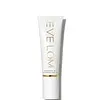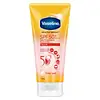Eve Lom Daily Protection SPF 50 Versus Vaseline Healthy Bright SPF50+ PA++++ Daily Protection & Brightening Serum Sunscreen
What's inside
What's inside
 Key Ingredients
Key Ingredients

 Benefits
Benefits

 Concerns
Concerns

 Ingredients Side-by-side
Ingredients Side-by-side

Water
Skin ConditioningHomosalate
Skin ConditioningBenzophenone-3
UV AbsorberNiacinamide
SmoothingEthylhexyl Salicylate
UV AbsorberPhenyl Trimethicone
Skin ConditioningCetearyl Alcohol
EmollientButyl Methoxydibenzoylmethane
UV AbsorberEthylhexyl Methoxycinnamate
UV AbsorberOctocrylene
UV AbsorberCaprylic/Capric Triglyceride
MaskingBehentrimonium Methosulfate
Divinyldimethicone/Dimethicone Copolymer
Polysilicone-15
UV FilterPhenoxyethanol
PreservativeCetearyl Olivate
Sorbitan Olivate
EmulsifyingPolyquaternium-37
Propylene Glycol Dicaprylate/Dicaprate
EmollientSpilanthes Acmella Flower Extract
Skin ConditioningTocopheryl Acetate
AntioxidantAscorbyl Tetraisopalmitate
AntioxidantEthylhexylglycerin
Skin ConditioningLactic Acid
BufferingPPG-1 Trideceth-6
Skin ConditioningC12-13 Pareth-3
EmulsifyingC12-13 Pareth-23
CleansingSodium Citrate
BufferingCitric Acid
BufferingBHT
AntioxidantWater, Homosalate, Benzophenone-3, Niacinamide, Ethylhexyl Salicylate, Phenyl Trimethicone, Cetearyl Alcohol, Butyl Methoxydibenzoylmethane, Ethylhexyl Methoxycinnamate, Octocrylene, Caprylic/Capric Triglyceride, Behentrimonium Methosulfate, Divinyldimethicone/Dimethicone Copolymer, Polysilicone-15, Phenoxyethanol, Cetearyl Olivate, Sorbitan Olivate, Polyquaternium-37, Propylene Glycol Dicaprylate/Dicaprate, Spilanthes Acmella Flower Extract, Tocopheryl Acetate, Ascorbyl Tetraisopalmitate, Ethylhexylglycerin, Lactic Acid, PPG-1 Trideceth-6, C12-13 Pareth-3, C12-13 Pareth-23, Sodium Citrate, Citric Acid, BHT
Water
Skin ConditioningC12-15 Alkyl Benzoate
AntimicrobialEthylhexyl Salicylate
UV AbsorberOctocrylene
UV AbsorberHomosalate
Skin ConditioningButyl Methoxydibenzoylmethane
UV AbsorberGlycerin
HumectantStearic Acid
CleansingPhenylbenzimidazole Sulfonic Acid
UV AbsorberGlycol Stearate
EmollientPEG-100 Stearate
Tocopheryl Acetate
AntioxidantSodium Ascorbyl Phosphate
AntioxidantNiacinamide
SmoothingGlyceryl Stearate
EmollientPetrolatum
EmollientCetyl Alcohol
EmollientSodium Hydroxide
BufferingTitanium Dioxide
Cosmetic ColorantCarbomer
Emulsion StabilisingXanthan Gum
EmulsifyingStearamide Amp
Aluminum Hydroxide
EmollientParfum
MaskingDisodium EDTA
Caprylyl Glycol
EmollientPhenoxyethanol
PreservativeWater, C12-15 Alkyl Benzoate, Ethylhexyl Salicylate, Octocrylene, Homosalate, Butyl Methoxydibenzoylmethane, Glycerin, Stearic Acid, Phenylbenzimidazole Sulfonic Acid, Glycol Stearate, PEG-100 Stearate, Tocopheryl Acetate, Sodium Ascorbyl Phosphate, Niacinamide, Glyceryl Stearate, Petrolatum, Cetyl Alcohol, Sodium Hydroxide, Titanium Dioxide, Carbomer, Xanthan Gum, Stearamide Amp, Aluminum Hydroxide, Parfum, Disodium EDTA, Caprylyl Glycol, Phenoxyethanol
 Reviews
Reviews

Ingredients Explained
These ingredients are found in both products.
Ingredients higher up in an ingredient list are typically present in a larger amount.
Also known as Avobenzone, this ingredient is a chemical sunscreen filter that provides protection in the UV-A range.
Avobenzone is globally approved and is the most commonly used UV-A filter in the world.
Studies have found that avobenzone becomes ineffective when exposed to UV light (it is not photostable; meaning that it breaks down in sunlight). Because of this, formulations that include avobenzone will usually contain stabilizers such as octocrylene.
However, some modern formulations (looking at you, EU!) are able to stabilize avobenzone by coating the molecules.
Avobenzone does not protect against the UV-B range, so it's important to check that the sunscreen you're using contains other UV filters that do!
The highest concentration of avobenzone permitted is 3% in the US, and 5% in the EU.
Learn more about Butyl MethoxydibenzoylmethaneEthylhexyl Salicylate is an organic compound used to block UV rays. It primarily absorbs UVB rays but offers a small amount of UVA protection as well.
Commonly found in sunscreens, Ethylhexyl Salicylate is created from salicylic acid and 2-ethylhexanol. You might know salicylic acid as the effective acne fighter ingredient and BHA.
The ethylhexanol in this ingredient is a fatty alcohol and helps hydrate your skin, similar to oils. It is an emollient, which means it traps moisture into the skin.
According to manufacturers, Ethylhexyl Salicylate absorbs UV wavelength of 295-315 nm, with a peak absorption at 307-310 nm. UVA rays are linked to long term skin damage, such as hyperpigmentation. UVB rays emit more energy and are capable of damaging our DNA. UVB rays cause sunburn.
Learn more about Ethylhexyl SalicylateHomosalate is a chemical sunscreen filter that provides protection in the UV-B range (280nm - 320 nm), with a peak protection at 306 nm. It is internationally approved for use in sunscreens.
Homosalate is not photo-stable, meaning it's strength as a UV filter degrades over time with exposure to the sun. Because of this, it's often used in combination with other chemical sunscreen filters as avobenzone (which protects from the UV-A range). Homosalate also helps act as a solvent for harder-to-dissolve UV filters.
(Part of the reason that sunscreens need to be frequently re-applied is due to the photo instability of many chemical sunscreen filters)
Currently, homosalate is approved in concentrations up to 10% in the EU and 15% in the US. The FDA is currently doing further research on the effects of homosalate, and it is possible that these approved concentrations will change in the future.
Learn more about HomosalateNiacinamide is a multitasking form of vitamin B3 that strengthens the skin barrier, reduces pores and dark spots, regulates oil, and improves signs of aging.
And the best part? It's gentle and well-tolerated by most skin types, including sensitive and reactive skin.
You might have heard of "niacin flush", or the reddening of skin that causes itchiness. Niacinamide has not been found to cause this.
In very rare cases, some individuals may not be able to tolerate niacinamide at all or experience an allergic reaction to it.
If you are experiencing flaking, irritation, and dryness with this ingredient, be sure to double check all your products as this ingredient can be found in all categories of skincare.
When incorporating niacinamide into your routine, look out for concentration amounts. Typically, 5% niacinamide provides benefits such as fading dark spots. However, if you have sensitive skin, it is better to begin with a smaller concentration.
When you apply niacinamide to your skin, your body converts it into nicotinamide adenine dinucleotide (NAD). NAD is an essential coenzyme that is already found in your cells as "fuel" and powers countless biological processes.
In your skin, NAD helps repair cell damage, produce new healthy cells, support collagen production, strengthen the skin barrier, and fight environmental stressors (like UV and pollution).
Our natural NAD levels start to decline with age, leading to slower skin repair, visible aging, and a weaker skin barrier. By providing your skin niacinamide, you're recharging your skin's NAD levels. This leads to stronger, healthier, and younger looking skin.
Another name for vitamin B3 is nicotinamide. This vitamin is water-soluble and our bodies don't store it. We obtain Vitamin B3 from either food or skincare. Meat, fish, wheat, yeast, and leafy greens contain vitamin B3.
The type of niacinamide used in skincare is synthetically created.
Learn more about NiacinamideOctocrylene protects skin from sun damage. It absorbs UV-B with peak absorption of 304 nm. It is a common sunscreen ingredient and often paired with avobenzone, a UVA filter. This is because octocrylene stabilizes other sunscreen ingredients by protecting them from degradation when exposed to sunlight. Octocrylene is a photostable ingredient and loses about 10% of SPF in 95 minutes.
Octocrylene also acts as an emollient, meaning it helps skin retain moisture and softens skin. It is oil-soluble and hydrophobic, enhancing water-resistant properties in a product.
Those who are using ketoprofen, a topical anti-inflammatory drug, may experience an allergic reaction when using octocrylene. It is best to speak with a healthcare professional about using sunscreens with octocrylene.
The EU allows a maximum of these concentrations:
Learn more about OctocrylenePhenoxyethanol is a preservative that has germicide, antimicrobial, and aromatic properties. Studies show that phenoxyethanol can prevent microbial growth. By itself, it has a scent that is similar to that of a rose.
It's often used in formulations along with Caprylyl Glycol to preserve the shelf life of products.
Tocopheryl Acetate is AKA Vitamin E. It is an antioxidant and protects your skin from free radicals. Free radicals damage the skin by breaking down collagen.
One study found using Tocopheryl Acetate with Vitamin C decreased the number of sunburned cells.
Tocopheryl Acetate is commonly found in both skincare and dietary supplements.
Learn more about Tocopheryl AcetateWater. It's the most common cosmetic ingredient of all. You'll usually see it at the top of ingredient lists, meaning that it makes up the largest part of the product.
So why is it so popular? Water most often acts as a solvent - this means that it helps dissolve other ingredients into the formulation.
You'll also recognize water as that liquid we all need to stay alive. If you see this, drink a glass of water. Stay hydrated!
Learn more about Water